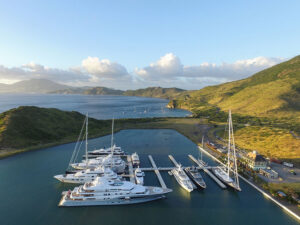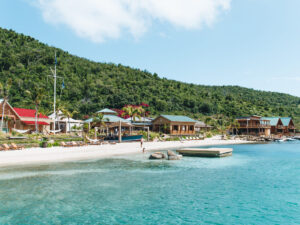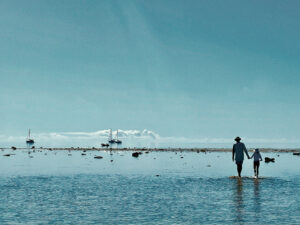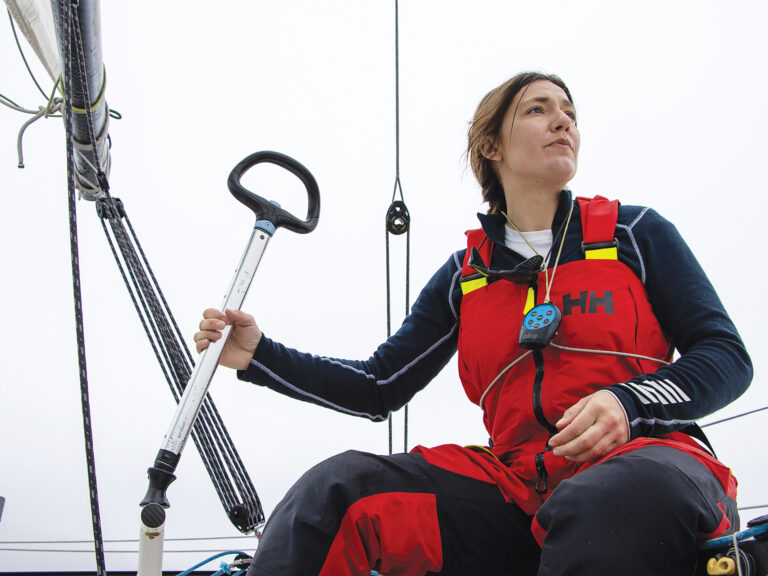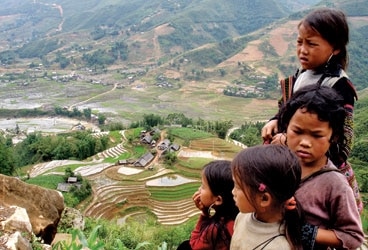
Remember Vietnam 368
In May, the litchi fruit ripens. Across Vietnam, women in coolie hats scurry along streets carrying double baskets hanging from shoulder yokes and laden with juicy delicacies. For two weeks, people stop to buy and devour this ambrosia, and they’re soon delirious with pleasure. In May, the daily rains begin, and the rice harvest commences up and down the paddies of the centuries-old stepped rice terraces, like staircases climbing the mountains to heaven. In May, the prevailing winds of spring begin blowing 15 knots-perfect for sailing along Vietnam’s central coast.
When I was a child, my Irish family, fresh to America in the early 1960s, subscribed to LIFE magazine, with its haunting photos of battle-weary American and Vietnamese soldiers. The week we got our first television, The Beatles debuted on The Ed Sullivan Show and Walter Cronkite showed us the Vietnam War, all images I’ll never forget. Two years ago, Vietnam allowed Sunsail to open the first-ever Vietnam chartering base; my husband, Douglas, and I booked a boat last year for what would be an emotionally moving and visually stunning sojourn.
Our explorations began next door, in Cambodia’s Angkor Wat, home to a vast jungle of carved temples dating back to the seventh century and built for the gods, on an unwavering belief that life is greater than one’s self. We then traveled to Vietnam’s southern coast, to the Mekong Delta’s green infinity of rice paddies. There, life is dominated by the river’s ebb and flow and its hundreds of miles of canals, snakelike veins irrigating the land; the river’s banks are lined with water hyacinth and floating markets where people sell their fruits and vegetables from sampans.
By train, bus, and car we meandered northward, to the covered markets and bustle of Ho Chi Minh City, formerly Saigon, then on to Hoi An, an antique treasure of a town whose architecture dates back to the 18th century and was luckily spared obliteration in the war. In Hoi An-known for its cuisine-we took a cooking class and befriended one of Vietnam’s most celebrated lacquer painters. Phong showed us his studio and introduced us to the members of his family, who live near a bomb crater the size of a large pond. During the rainy season, Phong’s father, a retired North Vietnamese soldier, fishes in the crater, where his grandchildren swim and play.
We traveled northward to Lao Cai and Sapa, into the cool relief of the mountains near China to hike among the hill-tribe villages where Black Hmong and Flower Hmong live peacefully, steering their water buffalo and plows across the paddies. Each tribe is named after its distinctive hand-woven clothing: the Black Hmong’s deep indigo robes embellished with intricate embroidery, the Flower Hmong’s colorful full skirts and blouses covered in a rainbow of stitching and appliques.
On a six-hour train ride from Saigon to Nha Trang, we sat across from a young Vietnamese couple whose wedding was in three days. They’d been apart for five years while Minh lived in Louisiana, managing her own nail salon and supporting her mother and little sister, and Long worked his family’s farm near Nha Trang. Entwined in each other’s arms, Minh quizzed her fiance in English using a TV Guide crossword-puzzle paperback to prep him for his new life in America.
Setting Sail
In Nha Trang, we piled our belongings and 10 bags of fresh produce from the Xom Moi market onto a Beneteau 42 named Tubtim, eager to be on a boat and in bathing suits again after three weeks of backpacking. Before us were 70 islands and 60 miles of Vietnam’s coast-as yet the only portion where Vietnam’s government allows pleasure boats. We headed for Hon Tre Island-a sail of only seven miles, but we wanted to beat an approaching front to an anchorage. The dramatic eight-mile island of inlets and protected anchorages was like an enormous green-velour comforter tossed in a heap by a sleepy giant.
Surrounding the island are pink-granite and limestone spires rising 200 feet straight up from the sea, like the Buddhist and Cham temples we’d seen throughout Vietnam and Cambodia. As we sailed Tubtim closer, we saw tiny Vietnamese flags flying from what looked like shrines clinging to the rock faces. Later, we realized these were shelters tucked into the soaring rocks and inhabited by the gatherers of swallows’ eggs. Every day these climbers hang on to small outcroppings as they make their way up, down, and around the spires, collecting the coveted eggs we’d seen for sale in the Xom Moi market.
As the clouds closed in, we sailed Tubtim into Dam Bai Bay inlet, dropped the sails, and motored into another world. Around us was a community of anchored fish camps-hundreds of small floating huts surrounded by large fish pens holding live inventory. Alongside were blue and red fishing boats-blue to honor the ocean, red to show respect for the blood of the fish. When fishermen collect enough fish in the pens, their wives sell the catch in the markets.
We anchored in 18 feet, Douglas jacked the iPod into the radio, and we settled in the cockpit with chart and cruising guide to plan our week. The chart was a U.S. government issue from 1968-the year of the pivotal Tet Offensive. Iron Butterfly’s In-A-Gadda-Da-Vida came on the iPod-the song that had been playing in 1969 when Douglas first learned of his draft number; luckily, in the end, he was spared time in the service.
The next morning, we sailed for Vung Fong Bay, 25 miles north. Imagine Ireland’s green mountains surrounded by the geometric boulders from The Baths at Virgin Gorda-but in pinks and yellows. Then, in the distance, lay out a vast Sahara of golden sand dunes. What a coast! We rounded Hon Lon Island, threaded the five-mile channel into Vung Fong Bay, and sailed toward Hon Ong, where we anchored in 15 feet. We didn’t budge for two nights of solitude: swimming, eating light for a change, and reading a book a day under the bimini’s shade.
One afternoon, puttering in the dink by one of the fish camps, we were invited in. The only way to board was via monkey ladders, 20-foot-long planks over fish pens to the hut. The fishermen and their dogs navigate these planks like tightrope walkers; to avoid falling into the pens, Douglas and I crawled, much to everyone’s amusement. Fishermen on other camps beckoned us over to welcome us and to enjoy the show; one gave us a watermelon as a gift.
Living to Eat?
Food plays a prominent role in our travels, during which all diets and discussions of diets are forbidden. Vietnam offered us a constant reason to play and experiment with local cuisine, which was delicious and healthy but occasionally required fortitude. One of the fishermen gave us mango marinated in salt and vinegar-awesome-and another offered us stuffed frog. Less awesome. Vietnamese people adore frog meat, which, according to frog-porridge zealots, has zero cholesterol and less fat than chicken.
We were offered roast porcupine, camel breast with chili, stir-fried dog, steamed cobra head, diced crocodile with cashews, fried pig’s feet. We preferred the delectable lotus-root salad with pork, pumpkin seafood soup, squid and lemongrass steamed in banana leaves, and fresh spring rolls dipped in chili, lemon, garlic, and fish sauce. My dentist at home, a decorated Vietnam vet, warned me before we left, “They make this fish sauce that’s the brine off rotten salted fish. I’m still nauseated even thinking about it.” Douglas and I say bring it on. But, then again, we weren’t Swift-boat drivers on the Mekong, which may have left a bitter taste in the mouth.
We sailed for Dam Mon village, at the foot of the sand dunes, and dinghied ashore, looking for spring rolls, our new favorite food. Unaccustomed to visitors, let alone enormous white ones, everywhere we walked small children ran out to hold our hands, saying, “Hello, auntie! Hello, uncle!” Vietnamese and Cambodian people treated us with grace everywhere, often greeting us with a slight bow, saying “Hello, sister,” or “Hello, brother,” sometimes putting their hands together, as if in prayer.
Early in the morning and late in the afternoon, people sat in the shade mending their fishing nets or playing the local version of hackey sack, kicking a feathered shuttlecock back and forth to one other, with the best players performing trick spins and lobs. We returned to find the dinghy a playpen of squealing urchins.
We sailed next to Mui Co Co Point and had it to ourselves. Ashore, steep mountains rose velvety and green. Birds and crickets sang out. On this vast bay, small fishing boats put-putted by after sunset, trailing thin little “teacups,” as Douglas and I called them: woven, tar-coated fishing baskets that the men sculled along as they distributed their nets. The fishermen all stared at our snow-white boat, too astonished to sell us their catch. We stood on Tubtim’s side deck impersonating castanet players before they realized we hoped to buy crabs.
The action was at night. Hundreds of small lights danced around the bay: guys in teacups laying out nets and traps on the black water. In the morning, a smiling couple in a small fishing sampan drifted up behind Tubtim and tied to our stern. A few hand gestures and some pointing and smiling transpired before we finally sorted this out. They simply wanted to visit for a gab while their crab traps were out-something fishermen do with each other all over the bay during the heat of the day.
If we’d come to Vung Fong Bay on board Ithaka, the 39-footer on which we’d lived and cruised for six years, we would’ve lingered for months! There are that many beautiful uncharted anchorages tucked into the crevices of the mountains. But with less time, we moved on, sailing 30 miles south into chop and contrary headwinds toward the Bai Tre anchorage, at the north side of Hon Tre and well protected from the southerly winds. The bay opened wide its rocky arms, we sailed into the green bosom of its mountain lee, and the boat calmed. The bay is a jaw-dropper. We anchored, grabbed our masks and fins, and jumped in to explore. Vietnam’s underwater world offers small miracles: a crop of neon-green ferns here, bright-blue starfish there, turquoise polka-dot Nemos chomping on lavender staghorn.
Strengthening southerlies drove a couple of fishing boats into our glassy refuge. While I showered on the stern-no shower in the world feels this good-Douglas dinghied over to say hello. He returned two hours later. It was our last night on Tubtim, so we brought some of our extra food to Douglas’s new friends as gifts. The next morning, one of the young fishermen sculled his teacup over to visit. On a chart of the coast, we showed him where we’d sailed. Hiew pointed to where his family lived. We invited him below; a guy, he was fascinated by Tubtim’s mechanics. Later that morning, just before we raised anchor to sail back to Sunsail mission control, Hiew returned in his teacup with six crabs he’d cooked for us-his entire day’s catch.
The Spires of Halong Bay
Vietnamese people can still tell you proudly the name of the first American pilot shot down and captured in Halong Bay: Antonio Alvarez. They can tell you about their fathers and brothers and uncles who were among the 3 million people killed and the 4 million wounded in what everyone here calls the American War. On the streets, we saw women and young families but precious few older men. They are no longer. Sixty percent of Vietnam’s population has been born since the war’s end; they have no direct memory of it.
Most towns have intimate war museums commemorating what they call their “victory over American imperialism.” In Can Tho, in the Mekong Delta, an entire wall of the museum there is devoted to dozens of framed portraits of the mothers of slain Can Tho army captains, each mother wearing her dead son’s medals, each face lined in inexpressible sadness. In the makeshift Hoi An museum, there’s a “Seat from the U.S. Helicopter that crashed into Mrs. Nguyen Thi Nhung’s garden” and the “Shell of a U.S. bomb that exploded Hoang Thi Doan Trang’s family home” and a “Sweater knitted of refuse synthetic rubber fibres by Mrs. Ha Ti Kiem-‘The warmest sweater my husband had for 10 years!'” To the Vietnamese, the American War remains highly personal.
In Cu Chi we visited the tunnels where 4,000 Vietnamese soldiers lived and worked in a clandestine 125-mile-long, 30-foot-deep underground labyrinth of dormitories, clinics, and weapon-making workshops-beneath American encampments. I crawled down into the narrow, dark, gravelike dirt tunnels and was immediately frightened by claustrophobia, stunned to see and feel what the North Vietnamese were willing to endure, and overwhelmed to understand better what our American troops were up against.
In the War Remnants Museum in Ho Chi Minh City, there’s a room of love letters written by field soldiers to their wives. Also on display is the famous 1972 LIFE magazine photo of a terrified naked child running from the American napalm. Next to it is a photo taken in 1996 of the photo’s subject as an adult; in it, Phan Thi Kim Phuc, her body disfigured from burns, holds her perfect baby to her breast.
Our last days on the water in Vietnam were spent aboard a lateen-rigged junk meandering through spectacular Halong Bay, a karst wonderland of 3,000 rocky spires rising 300 feet straight up out of the water. That Halong Bay, such a paradise, could have been a battleground is difficult to imagine. Now, one is only staggered by its beauty.
Coming to Vietnam is more than a vacation. One minute your mind is blown by a vista of inexpressible splendor; the next, by a teenager who’s had his legs destroyed by an old land mine. I asked a young guide we hired in Can Tho how Vietnamese people feel about Americans. “Now, we’re friends,” she said shyly. “But before, our parents didn’t want Americans here. Old people still have trouble. So many deaths. Then, nearly 10 years ago, America opened trade with us. President Clinton gave a speech at our university. Everyone in Vietnam got to a television. He said young people are the hope for our two countries, that we must vow never to repeat the past.”
“I hear and I forget,” said Confucius. “I see and I remember. I do and I understand.” Visiting Vietnam invites us to see the devastating long-term effects of war. It’s a complicated and heart-breaking and poignant journey at times. Traveling puts a face on the world.
Now I know Vietnam in the month of May, when early rains cool the air, water the rice, and shower upon the lateen rigs sailing through Halong Bay. I’ll remember the pretty Hanoi college girls in their fitted white tunics over flowing white pants-the traditional attire of student girls-cycling to their graduation ceremony at the Temple of Literature. I’ll remember the young Buddhist monks at the mountain temple at Angkor, heads newly shaven, giggling as they tangled themselves for the first time into saffron robes; I’ll remember hiking in the jungle near that temple, and finding an old rifle cartridge there.
Next May, I’ll think of a newlywed Vietnamese couple celebrating their first anniversary in Baton Rouge, and I’ll wonder how Long is faring in his new country. And I’ll remember a young fisherman named Hiew who shared his catch with us and how we sat and laughed and tried to understand each other.
Bernadette Bernon, a writer and CW editor at large, lives in Rhode Island. She and her husband, Douglas, wrote a cruising blog for BoatU.S. (www.boatus.com/cruising/ithaka).

